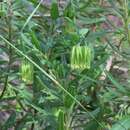en
names in breadcrumbs


Leionema viridiflorum commonly known as green phebalium,[2] is a species of flowering plant in the family Rutaceae. It is a small shrub with pale yellow-greenish flowers in clusters at the end of branches from winter to early spring. It has a restricted distribution in northern New South Wales.
Leionema viridiflorum is usually a small shrub to 1 m (3 ft 3 in) high with more or less needle-shaped stems covered in star-shaped, short, matted hairs. The leaves are mostly erect, narrowly oblong to oblong-elliptic, 20–40 mm (0.79–1.57 in) long, 4–8 mm (0.16–0.31 in) wide, wedge shaped at the base, apex lobed, smooth margins, rolled under or upward when dry, upper surface dotted with glands with occasional smooth to star-shaped hairs, underside more or less covered in star-shaped hairs. The inflorescence is a cluster of 6-12 pendulous flowers on a stalk 4–8 mm (0.16–0.31 in) long at the end of branches. The calyx are fleshy and hemispherical shaped. The erect, pale yellow-greenish petals are lance to narrowly oblong shaped, about 10 mm (0.39 in) long with occasional star-shaped, soft, erect hairs and the stamens twice the length of the petals. The fruit are a capsule, each segment about 6 mm (0.24 in) high, ending with a short beak. Flowering occurs from winter to early spring.[2][3]
This species was first formally described by Paul Wilson in 1970 and gave it the name Phebalium viridiflorum and the description was published in the journal Nuytsia.[4][5] In 1998 Paul Wilson changed the name to Leionema viridiflorum and published the name change in the journal Nuytsia.[6][7] The specific epithet (viridiflorum) means "green flowers".[8]
Leionema viridiflorum grows usually in heath on trachyte outcrops in the Warrumbungle National Park and Mount Kaputar National Park in New South Wales.[3]
Leionema viridiflorum commonly known as green phebalium, is a species of flowering plant in the family Rutaceae. It is a small shrub with pale yellow-greenish flowers in clusters at the end of branches from winter to early spring. It has a restricted distribution in northern New South Wales.